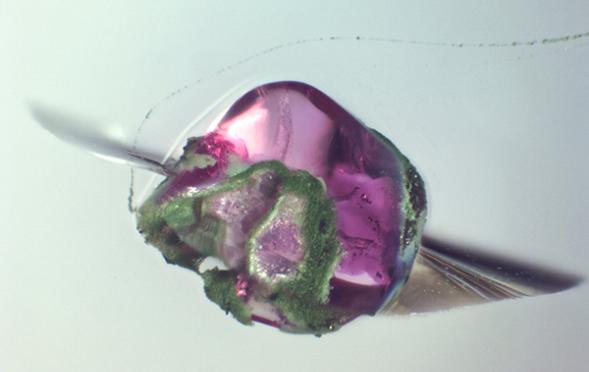Defect of the Month
Back to AGR's Library
Could we have inadvertently sprinkled our glass surface with microscopic, crisp-cut blocks of gouda? Or is this rectangular irregularity yet another one of our famous glass defects? In fact, this false-color SEM micrograph shows a well-defined, rhombohedral calcite crystal (CaCO3) produced by atmospheric weathering. When a glass surface reacts with moisture and CO2 in the air, calcium carbonate (i.e. calcite) and sodium carbonate crystals are created. This particular crystal was remarkable because most calcite crystals produced by weathering form in the shape of small hexagonal plates.

Did you know that furnaces in a glass plant can also make rubies? Due to its high melting point and chemical durability, alumina (Al2O3) is a common component of refractories. When alumina comes into contact with chromium, either from colorant or chromite refractories, it can be transformed into the red-colored variety of alumina – ruby. This particular stone originated from a chromite refractory in the throat of a furnace, and a fuzzy rind of chromic oxide (Cr2O3) is still clinging to the grain of alumina/ruby. Don’t plan on making a ring out of this gem any time soon – the grain is only 1 millimeter wide!

Gaseous inclusions of various shapes and sizes can occasionally be found in container glass. The gas inclusions are often designated as seeds or blisters, depending on their size. These gaseous inclusions can originate from different sources however they are all formed at melting temperatures ( > 1100oC), when glass is in the liquid state. The surface tension of the molten glass results in a spherical shaped bubble in the glass melt. During forming, the gaseous inclusion can assume either a round, oval or elongated shape depending on its location and the glass flow during the forming process. In this example, it appears as though the gaseous inclusion(s) could ‘fit’ together like puzzle pieces to once again form an oval shaped blister.

Jelly beans are especially popular this time of year, although the kidney-shaped confections from our galaxy don’t have the neon blue color of this very small stone. In fact, polarized light microscopy is responsible for the vibrant hues of this otherwise colorless crystalline grain. The tiny pores within the grain itself are characteristic of a manmade material known as tabular alumina (Al2O3). This form of alumina is used in many types of refractories, which most likely accounts for the origin of this stone.
Pagination
- Previous page
- Page 20
- Next page